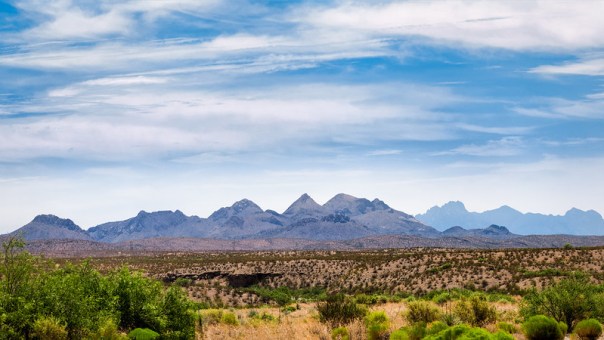This is a long article about Infrared (IR) image processing. If you don’t process IR photos, feel free to just look at the photos! And please take a look at the new Infrared Gallery I added under the Galleries / Portfolio menu at the top.
You probably know I like IR photography. I’ve written about it before (click here to review my posts) and I often include IR photos in this blog. Here’s a recent example:
 Circle B Bar Infrared 1 (four frame vertical panorama)
Circle B Bar Infrared 1 (four frame vertical panorama)
Infrared’s an interesting medium.
- IR captures invisible light: a portion of the spectrum that’s different from what your eyes can see.
- The spectral response makes blue sky look dark and foliage bright. This reverses a normal daylight scene’s brightness values. It helps tame contrast and allows you to shoot even when the sun is high in the sky.
- Since your eyes can’t see infrared, your interpretation of the alternate reality is up to you. You can process IR in Monochrome or as a false color image.
- IR can sometimes capture details that aren’t seen with visible light.
- If you use a modified digital camera, you may see improved detail in your photos. The conversion process removes the IR blocking / anti-aliasing filter. In many digital cameras this slightly blurs the image during capture to lessen Moire and other aliasing artifacts.
- I’m not really qualified to discuss shooting IR film – I’ve only done it a few times. But I will say that modifying a mirrorless digital camera is a great way to approach infrared. The mirrorless design eliminates any issues with IR focus. The camera’s built-in exposure meter works well and values are close to the normal visible light ones, so you can hand hold in daylight conditions.
Another example:
 Circle B Bar Infrared 3 (three frame vertical panorama)
Circle B Bar Infrared 3 (three frame vertical panorama)
By the way, all the images in this post are from from an early March trip to the Circle B Bar Reserve. I’m really glad I carried my IR camera on our hike! Here’s another:
Eight Cedar Waxwings – I forgot to bring the spare battery for my main camera and ran out of charge. So I switched my long lens to my IR modified body and kept shooting.
So what’s the point of this post? I’ve struggled lately with how I process my IR images. The work flow I’ve used seems to result in too much contrast / clarity. I just felt that the results looked a bit “digital”. So I’ve searched for new methods and I’ve found one that I like. I’ve used it on all these photos and I feel that they look much more “organic” and much less “digital”. What do you think?
Five nest Cypress (five frame vertical panorama)
Here is my updated workflow:
- Capture the RAW images with a modified micro 4/3 mirrorless camera. Aperture priority, mostly handheld (although I do occasionally use a tripod).
- Import into Lightroom to save the master files. Then decide which ones are worth processing and discard the seconds / rejects.
- Batch process the “selects” through DxO Optics Pro to take advantage of its noise and camera / lens module processing. This step returns copies back to Lightroom in Adobe DNG RAW format.
- In Lightroom, apply a custom camera profile to optimize the white balance (see this article for how to create one). And if it’s a multi-frame image, stitch it together with Lightroom’s merge to panorama function.
- Sometimes, you can use Lightroom’s B&W conversion and finish an image. But I’ll open ones I really like in Photoshop.
- There, straighten and crop, use the content aware fill, and clone if needed.
- And here’s the new step in my workflow: I’ve been using Skylum Software’s Luminar for IR B&W conversions. I found a very nice starting point for IR processing here: Laurie Klein’s Infrared Mastery presets.
- Finally, it’s back to Lightroom for any final adjustments (tone curve, sharpening, vignette, grain, etc.).
 Circle B Bar Infrared 6 (five frame horizontal panorama)
Circle B Bar Infrared 6 (five frame horizontal panorama)
Could I achieve this look some other way? Maybe even with a lot fewer steps? Yes, I’m sure it could be done.
 Circle B Bar Infrared 2 (three frame horizontal panorama)
Circle B Bar Infrared 2 (three frame horizontal panorama)
Just a few years ago, we only had Adobe Photoshop and then Lightroom to process RAW images. One of the great things about photography and image processing today is that there are so many ways to do things. That’s also bad, because it takes a lot of effort to study all the options and find out which ones work best. It seems like each program has strengths and weaknesses.
Software is changing every day, but I don’t know if there will ever be a single image processing program that does every thing I want. For now, I’m happy with the results I’m getting using this somewhat complex workflow. That doesn’t mean I’ll stop looking for new or simpler ways to do things.
If you have time, please take a minute to look through the new IR gallery. I think it represents some of my best IR images. I also have a Flickr album with many more IR photos at this link: https://www.flickr.com/photos/edrosack/albums/72157628062119778.
If you’ve read this far, thank you! That probably means you’re very interested in IR. If you have any questions about this, let me know in the comments and I’ll try to answer.
Thanks for stopping by and reading my blog. Now – go make some IR photos!
©2018, Ed Rosack. All rights reserved




































